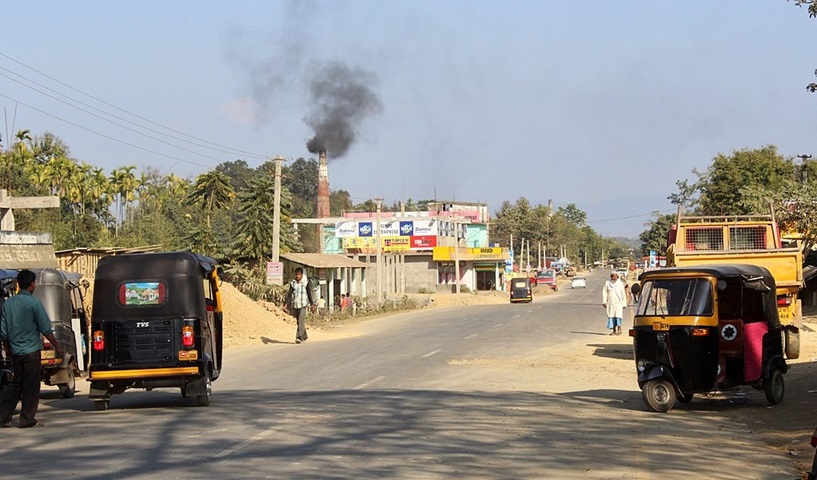.
Street 3/4
On both sides of this street, there are small stores
Of groceries, canned food, medicine, and toys.
Beside a Hindu shrine whose iron doors
Are always fanned, an art school for teen boys
Displays its billboard, saying, “Come! Let’s learn!”
This road I amble through once lay all dead
From heavy floods that wrecked it turn by turn,
But now, revamped, it has a gravel bed.
Most of the shopkeepers are known to me.
Though timeworn now, youth still glows on their faces
Like it did years ago. Senility
Can’t put them down. Their smiles bring back the traces
Of childhood days when I and my sole friend
Would gather at their shops, then sweep our eyes
Through every shelf. Our scanning had no end
Until we found some packs of flavoured pies.
Each evening, all these stores are meeting spots
For grown men who pick up the latest news
On sports and politics, exchange their thoughts,
And argue when there are conflicting views.
A few steps from Sanjeev’s department store,
There is a road where I don’t wander much.
Now filled with glass-walled outlets, but, before,
This place had no attraction points as such.
It seems as if this region’s just a whole
New area, an alienated part,
A living thing that doesn’t have a soul,
A place next to my home but far apart.
.
first published by Snakeskin
.
.
Shamik Banerjee is a poet from Assam, India, where he resides with his parents. His poems have been published by Sparks of Calliope, The Hypertexts, Snakeskin, Ink Sweat & Tears, Autumn Sky Daily, Ekstasis, among others. He received second place in the Southern Shakespeare Company Sonnet Contest, 2024.















Shamik,
What a mixture of emotions are in these lines, evoked by the mingling together of past and present in various stages of appearance and disappearance, blooming and decay, as you contemplate the scene before you, both with your physical eyes and with the eye of memory! A Hindu shrine–representing something very old in the history of India– is juxtaposed with “a school for teenage boys”, which represents something new, a learning center for the upcoming generation. The road on which you walk is itself both old and new– it was once wrecked beyond recognition, but has now been “revamped” and reborn, sporting a gravel bed. The shopkeepers represent a mingling of old with the new, for their worn out bodies are still graced with youthful smiles. The shops which they keep, which in the eye of memory is associated with the flavored pies of your childhood, before your physical eyes serves now as the meeting place for aging men to gather and discuss current events about a world which goes on, even as they themselves decline into obscurity. In the final image, the area of “glass-walled outlets,” we see a picture of newness transcending completely the past and leaving it behind altogether. Set apart in space from the world you knew growing up, of which traces still remain, you perceive that adjacent, yet distant assemblage of cold glass buildings as representing a future that is technically alive, but tragically devoid of a soul.
Very subtle imagery conveys a mood that is pleasantly wistful, but with an underlying tone of lament in response to the ephemeral nature of this present world– a world in which change and transformation do not always represent progress. As I read it, I was reminded of the words of Psalm 103:5– “As for man, his days are like grass; he flourishes like a flower of the field; for the wind passes over it, and it is gone, and its place knows it no more.”
Thank you for sharing this on SCP, Shamik! Blessings to you.
Mr. Rizley, I was rendered speechless for a while after reading your elaborate and heart-touching comment. You have summed the poem up so perfectly that even I couldn’t have done it better. Coursing through the lines, you have added every point and presented your personal feelings in addition to the three main themes: the juxtaposition of the old with the new, the present supplanting the past, and the lament that sits somewhere on the back of my head. Your take on the “glass-walled outlets” is absolutely accurate, and you’ve put the interpretation beautifully.
Psalm 103:5 summarises “life” in just a few words with a metaphor that’s easy to understand and remember. I’m glad you shared it with me.
Thank you so much for taking the time to read and comment on my piece and for your blessings. God bless you and your family with health and happiness.
The dissimilitude between past and present is stark and striking as you perambulate through the streets while memories compete with realities of the present day. Martin’s great comments appear to have absorbed the portrayed the essence of your intriguing poem. I can feel the emotions that are generated in your poem which I recognize are my own when I return to my own hometown of long ago. What a treat this was to read.
Mr. Peterson, the fact that you felt an emotion much like mine by reading this piece is itself a huge compliment. Returning to one’s hometown after a long time only to find things have altered and memories are all one has gives one a vacant feeling. I fully empathise with you. Thank you for reading and for this beautiful comment.
Dear Shamik,
Very quickly your poem your poem invited me to walk the road with you and hear your stories of this setting, even more to sense your range of feelings about a place that is part of your history. The image of the iron doors that are fanned particularly stands out to me. Thank you for this virtual walk.
Gigi
It was a delight to read your comment, dear Gigi. Such a wonderful thing to know that my poem gave you mental ambulation through the street. Also, I’m glad you like the fanned iron doors imagery. Thank you so much for reading and for this beautiful comment.
This poem touches upon an experience that many persons have today. The places and locales where we grew up are, when revisited, sometimes totally altered from what we remember. It is very disheartening. The frenetic, change-addicted nature of modern city life does not tolerate anything staying the same.
The quatrains are neatly composed, and the rhymes are all perfect. There is one slant rhyme (spots/thoughts) but it fits in smoothly.
I will make one minor criticism — in the first quatrain, the word “path” is not the best choice. In English “path” almost always connotes a very small and unpaved walkway, usually in a forest, a garden, or some rustic area. But in this poem Shamik is talking about a rather wide and paved commercial street with several active businesses on both sides. You would not normally use the word “path” to describe such a place. You can, of course, use the word “path” in a metaphorical sense, such as in “the path to salvation,” or “the path to happiness,” but if you are speaking of an actual roadway for foot traffic, “path” would have to be limited to a narrow and out-of-the-way trail.
You have rightly captured the essence of my poem, Mr. Salemi. Change is such a good obfuscator that when things actually go through its tunnel, we barely notice alterations, but years later, while walking or sitting in solitude and recalling the bygone days, a jolt of realisation regarding the extent to which things have changed hits us, just like it hit me during my ambulation through this street.
I fully agree with your point in regards to the use of “path.” After having a discussion with Mr. Bryant, I have decided to replace it with “street.” Thank you so much for your motivating comment and valuable guidance.
Simple subject, simply done–as it appears. The easy-reading quality of this poem is a feature that in fact takes a lot of work to achieve. Rhyme, meter, composition of stanza paragraphs: all are as comfortable as the small town theme. Then comes the uncomfortable conclusion, expressed in the wanderer’s wistful words. The contrast that sets up the conclusion is the living old versus the soulless new, and the old can win out and come back to life even after a flood that wipes it out. You show us, Shamik, where the life is, and leave us with the question of how or whether the new “alienated part” could ever come alive. We wander and wonder with you along this puzzling passage. Very well done.
Your wonderful words of appreciation for my poem have filled my heart with elation, dear Margaret. I am pleased to learn that you found this an easy-to-read piece. You’ve beautifully articulated the core theme of my poem and summarised the stanzas. Thank you so much. God bless you.